Charger AWT UTC
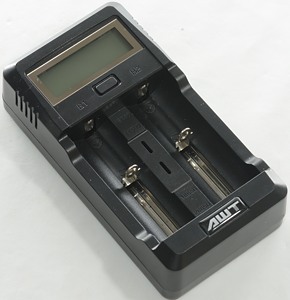


AWT (Aweite Battery Technology) is mostly selling batteries and chargers. This charger they have branded with their own name.
The charger has 3 current settings and can charge up to 26xxx batteries. It can also be used as a usb power bank.
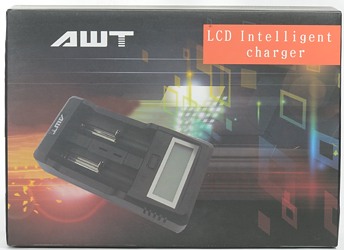
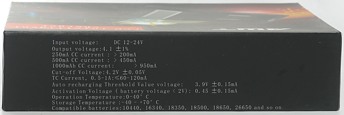
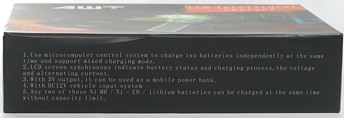
It comes in a cardboard box, the box lists the functions and specifications of the charger.
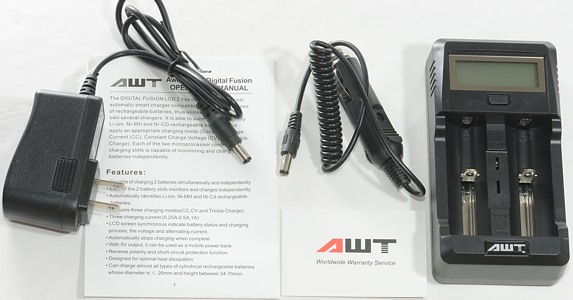
The box contains the charger, a universal voltage (100-240V 50/60Hz) mains power supply, a car power adapter, a warranty card and a instruction sheet.
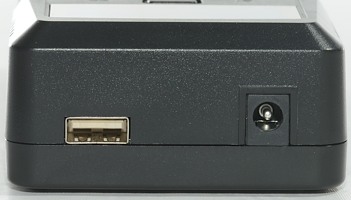
The charger has a DC power connector for the power supply and the car adapter. There is also a usb power output connector.

The user interface is a display and one button.
The button is used to change charge current, this can be done at any time.
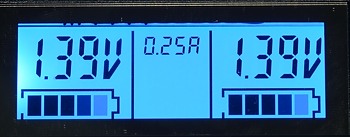
The display shows selected charge current, the voltage with two digits and a animation for charging or discharging when the usb output is turned on. The voltage is shown both when charging and when using usb output.
Thew background light is on while the charger is powered. It can be turned off/on by holding the button down.
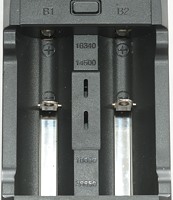
Some of the supported batteries are listed on the space between batteries, but the AAA/AA/C is missing (It is printed on the label on the back of the charger).

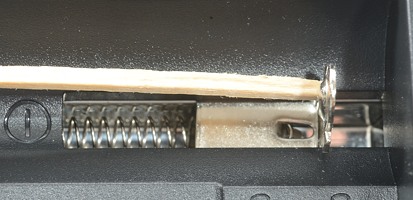
The battery cradle is made the usual way with a slider, it works fairly well, but not as smooth as I could have wished.
Batteries between 29.5mm and 69mm fits in the slot, this excludes some protected 18650 and 26650 cells.


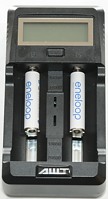
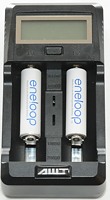

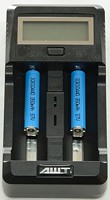
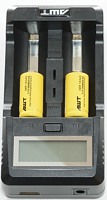
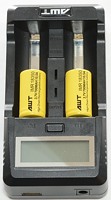
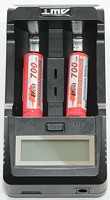
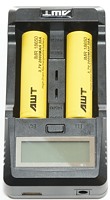

The charger can handle 69 mm long batteries including flat top cells.
Measurements
- Below 0.45 volt the charger will apply 4mA charge current and display will be off.
- Above 0.45 volt the charger will apply regular charge current.
- Above 2.0 volt charger assumes LiIon battery.
- Voltage readout will freeze if voltage is above termination voltage.
- Maximum voltage readout is about 4.25 volt.
- Charger will restart if voltage drops to 3.9 volt.
- Charger always starts with 0.25A charge current.
- Voltmeter shows within 0.02 volt.
- Charge will restart charging after power loss, or battery insertion.
- It is possible to change current during charge.
- When charging is finished the charger will apply 0.15mA charge current.
- The background light stays on when the charger is powered, except if manually turned off.
- When not connected to power it will drain about 15mA from a LiIon battery, but only 0.1mA from a NiMH battery.
Charging LiIon
%20%232.png)
The 0.25A charge is a fine CC/CV charge curve with a low termination current (About 25mA), this is perfect for smaller cells. I am a bit worried about the high charge voltage, but it is within allowable tolerances.
%20%231.png)
0.5A is also a good CC/CV charge, with the same low termination current.
%20%231.png)
Again with 1A the CC/CV is fine.
%20%232.png)
Same in the other slot.
%20%231.png)
Because the 2600mAh cell enters the CV phase fairly early, it needs the same charge time as the 3100mAh cell.
%20%231.png)
The 3400mAh cell takes longer to charge.
%20%231.png)
%20%231.png)
%20%231.png)
At low current the smaller cells charge fine.
%20%231.png)
Even using a 1A on my old 16340 IMR cell works fine.
.png)
Two cells works fine, but there is a mysterious spike at 200 minutes. I have no idea where it comes from, but it does not have much effect on the charge.
.png)
The charger needs about 1A input current to charge LiIon batteries.
The spike is also here, it can be seen on the voltage (red) trace.
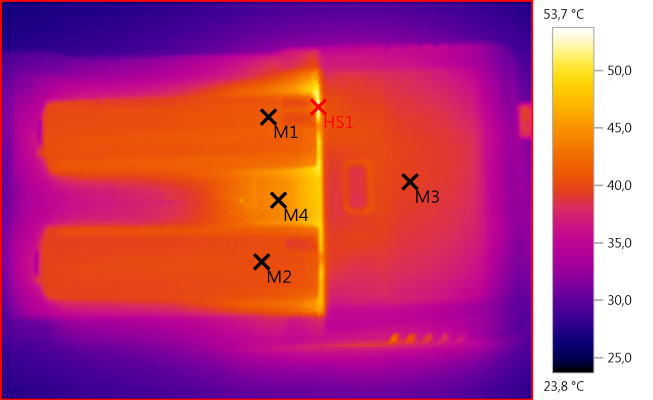
M1: 41,2°C, M2: 40,2°C, M3: 39,4°C, M4: 44,5°C, HS1: 53,7°C
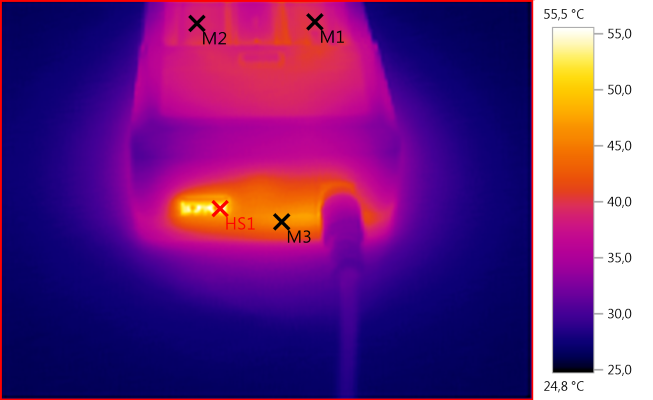
M1: 39,7°C, M2: 38,9°C, M3: 46,1°C, HS1: 55,5°C

The charger needs about 4 seconds from power on until it is charging.
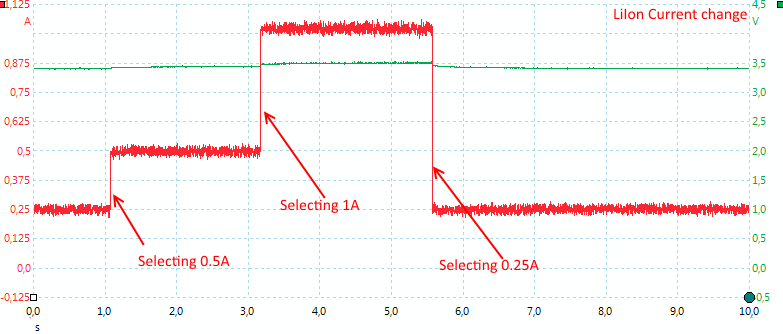
Current can be changed at any time and will switch very fast to the new current.
Charging NiMH
%20%231.png)
First test is with an eneloop at very low charge current. The charger misses termination (not very surprisingly), but stops after about 10 hours.
%20%231.png)
With 0.5A charge current the charger terminates when the battery is full (Temperature starts to raise) and has a 30mA trickle charge.
%20%231.png)
At 1A it does also terminate correctly, but the trickle charge is increased to about 50mA.
%20%232.png)
Slot #2 is the same.
%20%231.png)
The XX cell is also charged perfectly.
%20%231.png)
With the AAA cell at low current there is again problems with termination.
%20%231.png)
Increasing the charge current to 0.5A and it terminates perfectly.
%20%231.png)
With the powerex it also terminates perfectly.
It looks like 2000mAh eneloops is termination on voltage, but anything that is slightly lower in voltage will termination on -dv/dt.
.png)
With two cells everything is a bit warmer (as expected), but charging works just as fine.
.png)
The input current is about 0.5A when charging NiMH.

M1: 43,1°C, M2: 42,7°C, M3: 39,9°C, M4: 46,3°C, HS1: 56,2°C
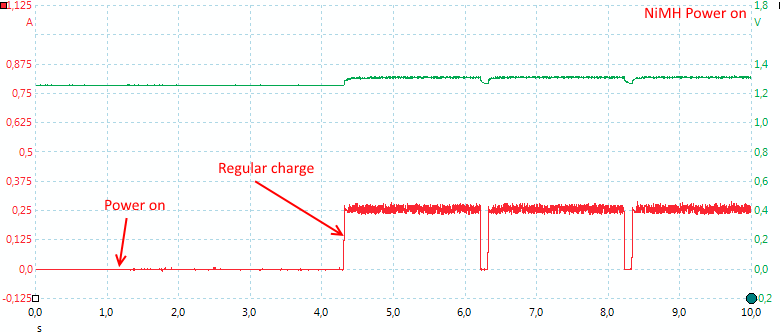
As usual with NiMH charges the current is pulsing when charging.

The current change can be used at any time.
LiIon & NiMH mixed charge
Here I have tested with one LiIon and one NiMH battery in the charger at the same time and done a measurement on each of them.
.png)
.png)
There is no problem mixing NiMH and LiIon when charging.
USB output
- With usb output turned on but not connected to anything the current draw is 26mA.
- USB output works from either battery slot or from both.
- USB output is disabled while charger is connected to power.
- When battery voltage is below 2.2 volt it will only drain 0.4mA from the battery.
- USB output can only deliver above 1A with two batteries.
- USB output is coded as Apple 1A.
- A short press on the button will turn usb output on/off.
- Display shows battery voltage while usb output is active.
- Animation in battery symbol shows discharge.
- Both batteries can be used for usb output.
- During heavy overload the display text will disappear.
- When using usb out with heavy load (1A), I have seen up to 0.1 volt difference between the display and my DMM.
- Empty battery symbol is flashing when battery is empty and output has shut down.
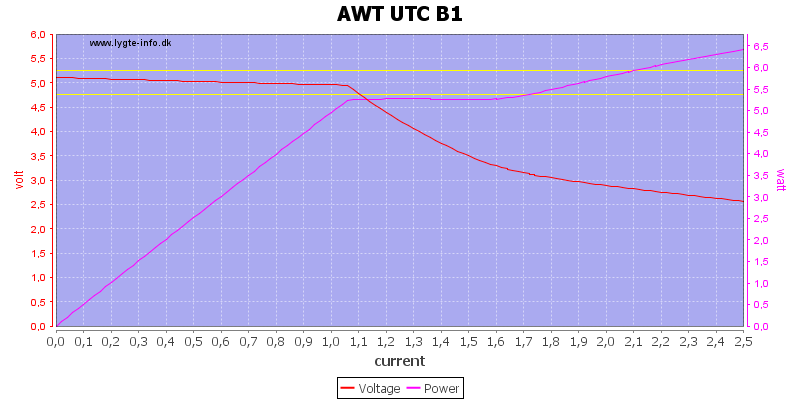
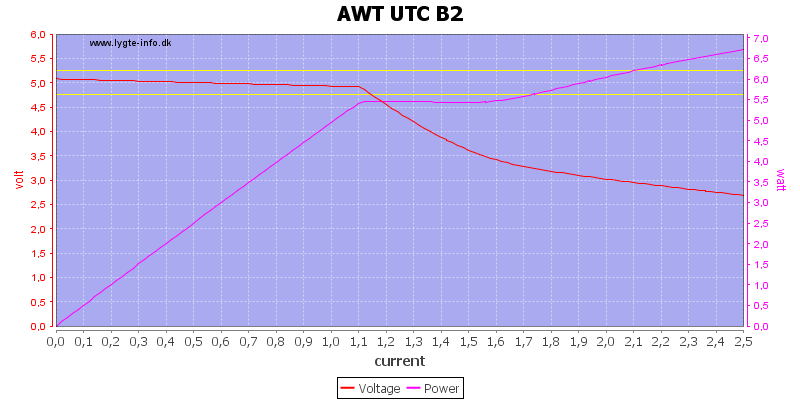
The usb output can deliver just above 1A on either battery. It does not look like there is any overload protection.

With two batteries it doubles the current.
%20%231.png)
%20%232.png)
Either channel works fine at 0.5A
.png)
When used together, one battery is used first, then the other battery.
Note: The efficiency calculation is invalid, I only measure current on one battery.
%20%231.png)
A smaller battery means shorter runtime.
%20%231.png)
And larger battery gives longer runtime.
%20%231.png)
%20%232.png)
With 1A load the output cannot maintain 5 volt when the battery is partial discharged.
.png)
Running with two batteries improves this significantly, until one of the batteries is empty.
.png)
It can deliver 2A for some time with two batteries.
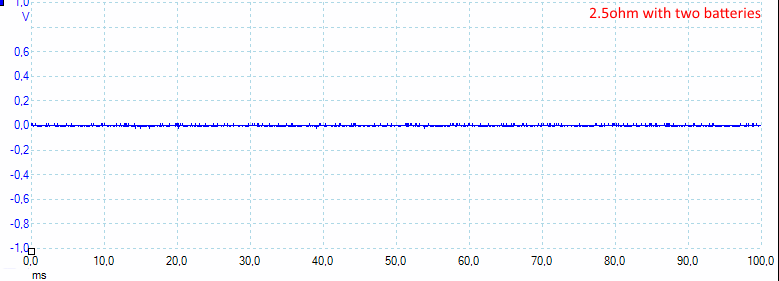
With two fresh batteries there are not much noise, even at 2A: 4mV RMS and 50mVpp.

At 1A with one battery there is 8mV RMS and 70mVpp.

At 0.5A with one battery there is 5mV RMS and 40mVpp.
Testing the mains input with 2500 volt and 5000 volt between mains and low volt side, did not show any safety problems.
Conclusion
This charger does a good job on both LiIon and NiMH, but with NiMH it is required to select high enough charge current.
The usb output could be better, but is fully useable.
Notes
The charger was supplied by AWT for a review.
Here is an explanation on how I did the above charge curves: How do I test a charger
Read more about how I test USB power supplies and chargers
























%20%232.png)
%20%231.png)
%20%231.png)
%20%232.png)
%20%231.png)
%20%231.png)
%20%231.png)
%20%231.png)
%20%231.png)
%20%231.png)
.png)
.png)




%20%231.png)
%20%231.png)
%20%231.png)
%20%232.png)
%20%231.png)
%20%231.png)
%20%231.png)
%20%231.png)
.png)
.png)



.png)
.png)



%20%231.png)
%20%232.png)
.png)
%20%231.png)
%20%231.png)
%20%231.png)
%20%232.png)
.png)
.png)


